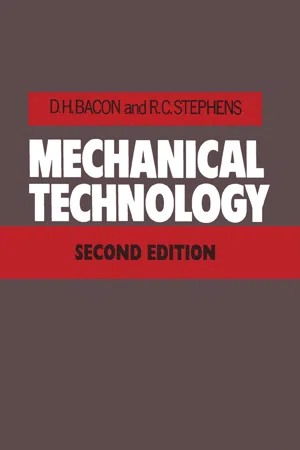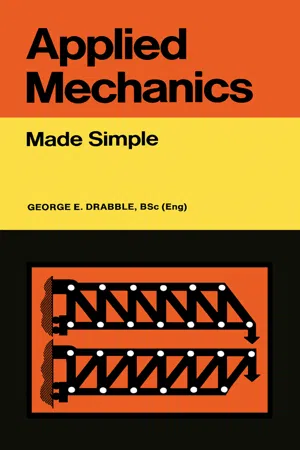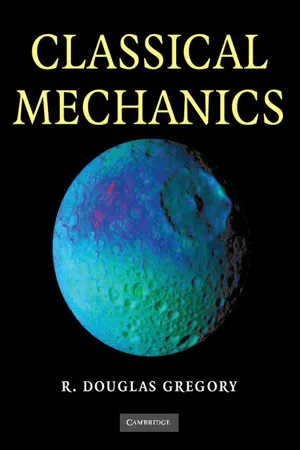Physics
Angular Motion and Linear Motion
Angular motion refers to the movement of an object around a fixed point, such as the rotation of a wheel. Linear motion, on the other hand, involves the movement of an object in a straight line from one point to another. Both types of motion are fundamental concepts in physics and are used to describe the movement of objects in the physical world.
Written by Perlego with AI-assistance
Related key terms
1 of 5
10 Key excerpts on "Angular Motion and Linear Motion"
- eBook - ePub
- William Bolton(Author)
- 2012(Publication Date)
- Routledge(Publisher)
4 Linear and angular motion 4.1 Introduction This chapter is concerned with the behaviour of dynamic mechanical systems when there is uniform acceleration. The terms and basic equations associated with linear motion with uniform acceleration and angular motion with uniform angular acceleration, Newton’s laws of motion, moment of inertia and the effects of friction are revised and applied to the solution of mechanical system problems. The terms scalar quantity and vector quantity are used in this chapter, so as a point of revision: Scalar quantities are those that only need to have their size to be given in order for their effects to be determined, e.g. mass. Vector quantities are those that need to have both their size and direction to be given in order for their effects to be determined, e.g. force where we need to know the direction as well as the size to determine its effect. 4.2 Linear motion The following are basic terms used in the description of linear motion, i.e. motion that occurs in a straight line path rather than rotation which we will consider later in this chapter: 1 Distance and displacement The term distance tends to be used for distances measured along the path of an object, whatever form the path takes; the term displacement, however, tends to be used for the distance travelled in a particular straight line direction (Figure 4.1). For example, if an object moves in a circular path the distance travelled is the circumference of the path whereas the displacement might be zero if it ends up at the same point it started from - eBook - PDF
- D H Bacon, R. C. Stephens(Authors)
- 2013(Publication Date)
- Newnes(Publisher)
10 Dynamics 10.1 Introduction Dynamics involves a study of the motion of systems and the forces associated with the motion, which may be linear, angular or a combination of linear and angular. 10.2 Linear motion The velocity, v, of a body is the rate of change of its displacement 5 from some reference position with respect to time, t, i.e. ds V = dt (10.1) The acceleration, a, of a body is the rate of change of its velocity v with respect to time, t, i.e. dv d 2 s dv dt dt 2 ds (10.2) If a body moves with uniform acceleration a such that the velocity changes from u to v in time t while traversing a distance s, then it may be shown that v = u + at (10.3) and s = ut + at 2 v 2 = u 2 + las (10.4) (10.5) ds ~~~dt Figure 10.1 DYNAMICS 131 10.3 Angular motion 10.4 Relations between linear and angular motion 10.5 Graphical interpretation of equations of motion For a body moving with angular velocity ω and angular acceleration a, turning through an angle Θ from some datum position, ω = -dö and άω d 2 0 da; a= dTd? = C °dö (10.6) (10.7) If the angular acceleration is uniform and the angular velocity changes from a>! to ω 2 in time t while rotating through an angle 0, then and ω 2 = ω 1 +αί ωΙ = ωΙ + 2<χθ (10.8) (10.9) (10.10) If a wheel of radius r turns through an angle Θ rad, the displacement of a point on the circumference, s = 6r (10.11) If the angular velocity of the wheel is ω and its angular acceleration is a, then by differentiation, the linear velocity and acceleration of points on the circumference are given by and v = a>r a = ocr (10.12) (10.13) If experimental data relating velocity, distance and time are available, equations (10.1) and (10.2) may be interpreted graphically, as shown in Figure 10.1. Solutions by this method are not restricted to cases of uniform acceleration. Graphs similar to those in Figure 10.1 may be used for experimental data involving angular motion. area = j^adi = v 2 — ν λ area = £ 2 ads = v~v] dv - eBook - PDF
- John Matolyak, Ajawad Haija(Authors)
- 2013(Publication Date)
- CRC Press(Publisher)
139 © 2010 Taylor & Francis Group, LLC Rotational Motion Translational motion and circular motion, uniform and nonuniform of an object, were discussed in Chapters 3 and 4. In this chapter, rotational motion of a point or extended object will be introduced. A force acting on an extended object creates a torque that rotates it about a fixed axis. A solid object of finite physical size is known as a rigid body. The axis of rotation could be about the center of mass of the rigid body or about other points where it is pivoted. In this chapter, Sections 8.2 through 8.7 discuss the kinematics of a rigid body, and Section 8.8 reviews the dynamics of the rigid body. In addition to drawing a parallel between Newton’s laws applied to point-like objects in linear motions and those applied to rotational motion of a rigid body, translational and rotational motions of a rigid body are discussed in detail. 8.1 ANGULAR KINEMATIC QUANTITIES Consider a point-like object moving in a circle of radius r (Figure 8.1). As the object moves from point P 1 at t 1 to point P 2 at t 2 , it sweeps through an arc Δ s that subtends an angle Δθ ( = θ 2 – θ 1 ) at the center, in a time interval Δ t = t 2 – t 1 . From geometry Δ s = r Δθ , (8.1) where Δθ is an angular displacement, measured in radians. To convert an angle expressed in degrees to radians, the following relation may be used: θ π θ rad deg deg 2 rad 360 = , (8.2a) and from radians to degrees, the conversion is θ π θ de g r ad 360 2 . = (8.2b) Dividing Equation 8.1 by Δ t gives the average linear velocity v ; that is, ∆ ∆ ∆ ∆ s t r t = θ or v r . = ω (8.3) For an object experiencing a constant linear acceleration, v v v 2 1 2 = + . 8 140 Essential Physics © 2010 Taylor & Francis Group, LLC Here, v 1 and v 2 are the instantaneous tangential, or linear, velocities of the object at points P 1 and P 2 , respectively. - eBook - PDF
Applied Mechanics
Made Simple
- George E. Drabble(Author)
- 2013(Publication Date)
- Made Simple(Publisher)
Now let us look at the velocity of our spinning body. To represent the angular velocity of spin we shall use the Greek letter ω (pronounced omega). (You must excuse the use of Greek letters, but they are so common in applied mechanics that to replace them would cause more confusion than it would remove.) The units in which ω is measured are radians per second. In Fig. 6 (a) we can observe the displacement of a point P in an interval of time t. If the linear velocity along the curved path is «, it will travel a distance along this path of ut; similarly, the corresponding angular displacement (in radians) will be ω/. But we know that x = r x Θ. Therefore, ut = r x ωί. Hence: u = r x ω (a) (b) (c) Fig. 6. The linear velocity is the product of angular velocity and radius. The linear acceleration is the product of angular acceleration and radius. 18 Applied Mechanics Made Simple By a simple extension of the argument a corresponding relationship can be found between the linear acceleration a and the angular acceleration in radians per second per second, which is usually designated by a (alpha). The equation is: a — r x a We shall have occasion to return to these relationships when we examine the kinetics of angular motion in Chapter Four. Meanwhile, the motion itself can be analysed by a set of four equations which are the exact counterparts of those already stated for straight-line motion. Using the notation and 2 for the initial and final angular velocities, the four equations are: 2 = tu! -- at (1) = i(coi + co 2 ), (2) 2 2 = 2 + 2 (3) - ,/ + -Ja/ 2 (4) Comparison of these equations with those on page 14 will reveal that they are in all respects exactly analogous. (6) Motion in a Circular Path Let us now examine the special case of the motion of a body which moves around a circular path at a constant speed which we will designate by v. - eBook - PDF
- W. C. Bolton(Author)
- 2013(Publication Date)
- Wiley-Blackwell(Publisher)
Chapter 10 Linear and angular motion 10.1 Linear motion Consider a particle moving along a straight line so that at some time t its displacement along the line from some reference point is s . If in a time interval δ t the displacement increases by δ s then the average velocity of the particle during that time interval is defined as being δ s / δ t . As the time interval considered is reduced, so the average velocity approaches the velocity at an instant. Thus, in the limit, the instantaneous velocity v is v = d s d t [1] If the velocity of the particle changes by δ v in a time interval δ t then the average acceleration is defined as being δ v / δ t . As the time interval considered is reduced, so the average acceleration approaches the acceleration at an instant. Thus, in the limit, the instantaneous acceleration a is a = d v d t [2] It is sometimes useful to express acceleration as a = d v d t = d v d s × d s d t = d v d s × v Example An element in a machine accelerates from rest in a straight line such that its velocity v in m/s changes with time t in s according to v = 0 . 8 t 2 + 0 . 2 t . What is the acceleration and distance covered after 2 s? Using equation [2], a = d v d t = d d t ( 0 . 8 t 2 + 0 . 2 t) = 1 . 6 t + 0 . 2 Thus after 2 s the acceleration is 3.4 m/s 2 . The distance covered can be obtained by using equation [1]. v = d s d t = 0 . 8 t 2 + 0 . 2 t 254 Linear and angular motion 255 s 0 d s = t 0 ( 0 . 8 t 2 + 0 . 2 t) d t s = 0 . 8 3 t 3 + 0 . 2 2 t 2 Thus when t = 2 s then s = 2 . - eBook - PDF
- R. Douglas Gregory(Author)
- 2006(Publication Date)
- Cambridge University Press(Publisher)
Any motion of the rigid body must maintain this framework. An important type of rigid body motion is rotation about a fixed axis; a spinning fan, a door opening on its hinges and a playground roundabout are among the many examples of this type of motion. Suppose B is a rigid body which is constrained to rotate about the fixed axis Oz as shown in Figure 2.6. (This means that the particles of B that lie on Oz are held fixed. Rotation about Oz is then the only motion of B consistent with rigid- ity.) At time t , B has angular displacement θ measured from some reference position. The angular displacement θ is the rotational counterpart of the Cartesian displacement x of a particle in straight line motion. By analogy with the rectilinear case, we make the following definitions: Definition 2.4 Angular velocity The angular velocity ω of B is defined to be ω = d θ/dt and the absolute value of ω is called the angular speed of B. Units. Angular velocity (and angular speed) are measured in radians per second (rad s −1 ). Example 2.8 Spinning crankshaft 1 The crankshaft of a motorcycle engine is spinning at 6000 revolutions per minute. What is its angular speed in S.I. units? Solution 6000 revolutions per minute is 100 revolutions per second which is 200π radians per second. This is the angular speed in S.I. units. Particle velocities in a rotating rigid body In rotational motion about a fixed axis, each particle P of B moves on a circle of some radius ρ , where ρ is the (fixed) perpendicular distance of P from the rotation axis. It then follows from (2.16) that the circumferential velocity v of P is given by ρ ˙ θ , that is v = ω ρ (2.18) 38 Chapter 2 Velocity, acceleration and scalar angular velocity Example 2.9 Spinning crankshaft 2 In the crankshaft example above, find the speed of a particle of the crankshaft that has perpendicular distance 5 cm from the rotation axis. - eBook - PDF
Mechanotechnics N6 Student's Book
TVET FIRST
- Sparrow Consulting(Author)
- 2021(Publication Date)
- Macmillan(Publisher)
235 Kinematics TVET FIRST Summary of Module 8 ● Motion is the change in position of an object with respect to time. ● The reference frame is a reference point (point of origin) combined with a set of directions. ● Relative motion is the object’s position from the point of view of another object that is fixed. ● Absolute motion is the motion of an object from the origin. ● Relative velocity is the speed of an object from the point of view of another object that is at rest. ● Kinematic analysis is an analysis of the motion of objects without considering the causes. ● The velocity of A relative to B is the difference between the absolute velocity of A and the absolute velocity of B. o Vector notation: v ̅ AB = v ̅ A − v ̅ B or v ̅ A = v ̅ B + v ̅ AB ● The acceleration of A relative to B is the difference between the absolute acceleration of A and the absolute acceleration of B. o Vector notation: a ̅ AB = a ̅ A − a ̅ B or a ̅ A = a ̅ B + a ̅ AB ● Relative acceleration is the acceleration of an object from the point of view of another object that is at rest. ● A rigid body is a body that does not deform or change shape. ● Linear motion is motion in a straight line. All the parts of an object move together simultaneously from one point to another along a straight line and in one direction. ● Angular motion is rotational motion. It occurs when all the points on a body or object move in a circular path about the same fixed central line or axis. ● A machine is a rigid mechanical device or resistant collection of mechanisms used to change, transmit and direct forces to accomplish a specific objective. ● A mechanism forms the heart of a machine and consists of the mechanical parts of the machine. ● A kinematic pair is formed where two links of a machine are in contact with each other. ● A kinematic chain is a series of linkages. ● A four-bar chain is a movable closed chain linkage consisting of four links, including the ground link and four kinematic pairs. - eBook - PDF
- H. W. Harkness(Author)
- 2014(Publication Date)
- Academic Press(Publisher)
Torque and angular acceleration appear, of course, instead of force and linear acceleration, and in place of the mass this new quantity, the moment of inertia, appears. Just as the mass of a body is measured by the ratio of the applied force to the resulting linear acceleration, so the moment of inertia is measured by the ratio of the applied torque to the resulting angular acceleration. It is to be noticed that the moment of inertia must always refer to a particular axis, and in the equation for angular motion, the axis around which the torque is taken must be the same axis for which the moment of inertia is measured. From the expression / = r 2 dM (1-3) it is clear that the moment of inertia involves not only the mass of the body but also the distribution of the mass about the axis in question. It is a scalar quantity just as mass is and so if we know the moments of inertia of any component parts of a body for the same axis, these may be added up to give the total moment of inertia about this axis just as one may add up the masses of component parts of a body to give the total mass. (ii) To calculate the momentum of the rigid body when it has reached an angular velocity of ω rad/sec we proceed, as before, to write down the momenta of the elementary particles and sum these over the whole body. Before doing so we define a quantity which we call the moment of momentum of a particle or the angular momentum. If a particle, m y as in Figure 1-3 has a velocity v we define its moment of momentum round the point 0 as the product of its momentum, 6 I. RIGID BODY MOTION AROUND A FIXED AXIS mv y and the distance r of the point O from the line of the momentum vector. The student will recognize the similarity to the definition of the moment of a force. The moment of momentum is also called the angular momentum. / ^ m i ^ l I O FIG. 1-3 Consider the rigid body represented in Figure 1-4 which is rotating round the axis O with an angular velocity ω rad/sec. - Paul Anthony Russell(Author)
- 2021(Publication Date)
- Reeds(Publisher)
One radian r r ▲ Figure 2.7 Angular displacement of 1 radian Kinematics • 45 Equations Similar to linear motion, angular motion has different equations that may be developed from the relationship between displacement, velocity, acceleration, and time: ω ω 1 2 : : initial angular velocity (rad/s) final angular velocity (rad/s) angular uniform (constant) acceleration (rad/ α : s s time in s angular displacement (rad) 2 ) : : t θ ω ω α θ ω ω θ ω α ω ω αθ 2 1 = ± ± ± ( ) = + ( ) = ( ) = ( ) t t t t i 1 2 1 2 1 1 2 2 2 2 1 2 2 ( ) ii iii iv Examples 2.9 and 2.10 are ones that would be relevant to marine engineering. The design engineers would need to use the actual calculations, but the operational engineers would also need to know them so that they may appreciate the correct operation of the machinery. This will enable the on-board team to be able to diagnose faults, initiate and undertake repairs and know about quality replacement, parts, etc. Example 2.9. A flywheel increases speed uniformly from 150 rev/min to 350 rev/min in 30 s. Calculate its acceleration. ω π ω π 1 2 2 150 60 15 71 2 350 60 36 65 = × = = × = . . rad/s rad/s From equation (i) above, ω 2 = ω 1 + αt 36 65 15 71 30 20 94 30 0 698 2 . . . . = + = = α α angular acceleration rad/s Example 2.10. A shaft rotating at 40 rev/min is retarded uniformly at 0.017 rad/s 2 for 15 s. Calculate (i) its angular velocity at the end of this time and (ii) the number of revolutions turned by the shaft during this 15 s. 46 • Applied Mechanics acceleration, rad/s rad/s α ω π ω ω α ω = - = × 40 = = + 0 017 2 60 4 19 2 1 2 1 2 . . t = - ×15) = = × 6 4 19 0 017 3 93 3 93 2 . ( . . . ω rad/s final angular velocity 0 = 2 37 53 π . rev/min Ans. (i) θ ω ω = + = + × = 1 2 1 2 1 2 4 19 3 93 15 60 9 ( ) ( . . ) . t rad number of revolutions = = 60 9 2 9 96 . . π Ans. (ii) Relationship Between Linear and Angular Motion Consider a point moving around on a circular path.- eBook - PDF
- Richard C. Hill, Kirstie Plantenberg(Authors)
- 2013(Publication Date)
- SDC Publications(Publisher)
The difference is that polar coordinates are most useful when the particle's motion is described with respect to an inertial reference frame. This means that some or all of the information about the particle's distance from the inertial reference frame (r) as well as the rotation of the polar coordinate frame with respect to the inertial reference frame () are given. One common example is circular motion. In this case, the motion is described with respect to the circle's center. It is also useful when angular velocities ( ) and accelerations ( ) are given. Conceptual Dynamics Kinematics: Chapter 3 – Kinematics of Particles - Curvilinear Motion 3 - 64 Position: r r r e (3.5-7) Velocity: r r r v e e (3.5-8) Acceleration: 2 2 r r r r r a e e (3.5-9) a = total acceleration v = total velocity r = position r = radial position along the r-axis r = radial velocity r = radial acceleration = angular velocity = angular acceleration Conceptual Example 3.5-1 The rocket shown in the figure below travels vertically upward with velocity v. The radar is located a known distance D from the rocket’s launch site and tracks the rocket’s flight. If the angular velocity and angular acceleration of the radar dish are known, which coordinate system would you employ if you wished to find the rocket’s velocity v when the rocket has reached an altitude of h? a) Rectangular coordinates b) Normal-tangential coordinates c) Polar coordinates Conceptual Example 3.5-2 The tank shown in the figure fires a shell with initial velocity v at an angle with the horizontal from a height h. If the horizontal distance D traveled by the shell is known, which coordinate system would you employ if you wished to find the shell’s initial velocity v and firing angle ? a) Rectangular coordinates b) Normal-tangential coordinates c) Polar coordinates
Index pages curate the most relevant extracts from our library of academic textbooks. They’ve been created using an in-house natural language model (NLM), each adding context and meaning to key research topics.









